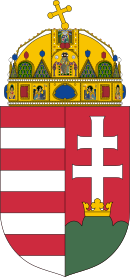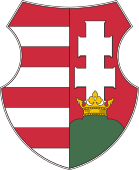Hungarian coat of arms
| Hungarian coat of arms | |
|---|---|

|
|
| Details |
The Hungarian coat of arms is split, on the right the old coat of arms of Hungary (Old Hungary) , on the left the new coat of arms (New Hungary) . The crown of St. Stephen rests on the coat of arms . The new coat of arms is probably older.
Components
New Hungary: the double cross
The "new" coat of arms, which is actually the older one, shows a silver (white) double cross ( patriarchal cross) in red on a green three-mountain , which stands in a golden crown . The double cross in the coat of arms dates from the 9th century, the three mountains ( Tátra , Fátra , Mátra ) from the early 14th century, the crown under the cross was added at the beginning of the 17th century. The first Christian king of Hungary, Stephen the Holy , integrated the double cross into the royal badges at the time of Pope Sylvester II in the year 1000 on March 27th. The cross stood for the apostolic dignity of the Hungarian king.
In the Middle Ages, the "new" coat of arms temporarily stood for the Principality of Neutra and for northern parts of the Kingdom of Hungary ( known as Upper Hungary since the 18th / 19th centuries ), roughly equivalent to the area of today's Slovakia. This is one of the reasons why it has officially been used as the coat of arms of Slovakia (then initially of the Slovak National Council ) since 1848 . The only difference to the new coat of arms is the lack of the crown and the use of the Slavic colors blue - white - red instead of the Hungarian green - white - red.
Old Hungary: the horizontal stripes
The "old" coat of arms shows four red and four silver (white) horizontal stripes. Its origin and meaning are controversial. Apparently it originated as a symbol of the Hungarian rulers of the southern border duchy of Hungary, created in Croatia and Dalmatia at the end of the 11th century. It was first used by the border duke Emmerich von Árpád , who later became King of Hungary (1196–1204), and then his successor in Croatia , Andreas , who was also later King of Hungary (1205–1235). According to another opinion, the coat of arms did not emerge until 1198, when Emmerich married the princess Constanceia of Aragón and created his own coat of arms by changing the coat of arms of the Aragon family (today's coat of arms of Spain ). There is still the opinion that the "old" coat of arms had a certain meaning. The most common interpretations are:
- it was a symbol of the Árpáds (counter-argument: it was not inherited)
- it was a symbol of the unification of all countries of the Hungarian Kingdom
- the four stripes symbolized the four main rivers of the kingdom ( Danube , Tisza , Drava and Save )
The coat of arms is crowned by the Stephanskrone , the Hungarian royal crown.
history
| The parts of the coat of arms of the Hungarian Kingdom | |
|---|---|
 The coat of arms of the Kingdom of Hungary 1915 |
|
| Stephanskrone (above) | |
| Dalmatia | Croatia |
| Slavonia | Transylvania |
| Bosnia | Fiume |
| Hungarian coat of arms (middle) | |
The “new” coat of arms of Béla III was the first coat of arms of the king in the true sense of the word. used in a crusade, then without the three mountains. His successors Emmerich (1196–1204) and Andreas II (1205–1235) used the “old” coat of arms. When the country was temporarily divided into two parts under Béla IV (1235–1270) in 1262, the "new" coat of arms was the symbol of the northwestern part and the "old" coat of arms that of the other part under the sovereignty of Stephen V. The last king from the family of the Árpáden , Andreas III. (1290–1301), again used the double cross. During the battles for the throne after the Árpáden died out, the Bohemian King Ladislaus V (1305–1306) and his successor Otto von Bayern (1305–1307) led only north-west Hungary (about the area of what is now western Hungary , Burgenland ) and western Slovakia dominated the “new” coat of arms, including the three mountains. Karl Robert von Anjou (1307-1342), on the other hand, used a two-part coat of arms consisting of the symbol of the Anjou family and the "old" coat of arms (stripes) of the former King Stephen V (see above), whose daughter Maria he married.
From the late 14th century the “new” coat of arms was used both as a symbol for Upper Hungary ( partes Danubii septentrionales, partes regni superiores , the area of today's Slovakia and northeastern Hungary), as well as a symbol of the Hungarian kings. As a symbol for Upper Hungary it was used together with the three mountains, as the symbol of the Hungarian kings, however, rather without the three mountains. The state symbol of Louis the Great (1342-1382) was a four-part coat of arms, which was derived from the symbol of Karl von Anjou (which in turn contained the "old" coat of arms) as the symbol for the southern parts of Hungary ( partes regni inferiores ) and next to it is composed of the "new" coat of arms as the symbol for Upper Hungary. A good example of the double meaning of the double cross is the great seal of King Sigismund of Luxembourg (1387–1437). Although this contains the "new" coat of arms in the middle, it is surrounded by the coat of arms of the areas ruled by Sigismund, which are placed in a circle, including the "old" coat of arms as the symbol for Pannonia and the "new" coat of arms a second time as the symbol for Upper Hungary is located.
Since the Habsburgs became the kings of what was left of the Kingdom of Hungary after the Turkish conquests in 1526 , the current Hungarian symbol has been used. The small crown under the cross was only added in the 17th century.
At times there was a large national coat of arms, which, like that of King Sigismund, contained the symbols of other parts of the country and had today's coat of arms in the middle.
Lajos Kossuth replaced this coat of arms during the revolution of 1848/1849 with a coat of arms without a crown of St. Stephen , in order to confirm Hungary's independence from Austria and the republican spirit of the revolution. In addition, the Kossuth coat of arms had a special shield shape that was curved inward on the top and sides . After the suppression of the revolution, the monarchist coat of arms was reintroduced - after the political settlement of 1867 , it formed the coat of arms of the Austro-Hungarian dual monarchy , now together with one with the Imperial-Austrian double-headed eagle . At the same time, Hungary also received an independent coat of arms , which was based on the old royal or the Kossuth coat of arms and was provided exclusively with the St. Stephen's crown at the top (without the double-headed eagle and the Austrian national colors) - since 1990 this Hungarian compensation coat of arms from 1867 has been the national coat of arms again of the country.
After the First World War , the royal coat of arms was abolished in 1918. For a short time, Kossuth's republican coat of arms from 1848 was in effect again, but was soon replaced by the Red Star during the short communist dictatorship of the Soviet Republic in 1919 . After its suppression and the reintroduction of the monarchy in 1919 ( without a king, with a permanently vacant throne under the imperial administrator Miklós von Horthy ), the royal coat of arms with St. Stephen's crown was in effect again until 1944, but expanded with two angels floating on the side.
When the fascist Arrow Cross Party came to power in 1944, the angels on the side were omitted; instead, the coat of arms was placed on a dark green arrow cross (eponymous symbol of the Arrow Cross Party) and a red H (for their ideology "Hungarism").
From 1946 to 1949 the republican Kossuth coat of arms from 1848 was in effect again. After the Communists came to power in 1948, the Stalinist coat of arms with hammer and ear (as a symbol of workers and peasants), framed by a corn wreath with a red star, was applied from 1949 Unofficially called the Rákosi coat of arms to the Stalinist Communist Party leader Mátyás Rákosi .
This Stalinist coat of arms (hated by large parts of the population) was abolished in 1956 as a result of the Hungarian popular uprising (the Hungarian flag with the Rákosi coat of arms cut out was one of the symbols of the uprising), under the government of Imre Nagy the Kossuth coat of arms was again in effect . After the uprising was put down with Soviet help, the new government under János Kádár had a new coat of arms designed, which symbolized the restoration of the communist dictatorship, but at the same time nominally distanced itself from Stalinism. In the new coat of arms from 1957 - unofficially called the Kádár coat of arms - hammer and ears of corn were omitted , instead the wreath of grain with a red star was only a shield-shaped coat of arms ( similar to the Kossuth coat of arms ) with the Hungarian national colors.
After the collapse of communism in 1989, there were sometimes heated discussions in the Hungarian parliament in the summer of 1990 about Hungary's new, democratic national coat of arms. Many MPs spoke out in favor of the republican Kossuth coat of arms from 1848 (shield-shaped and without St. Stephen's crown), but finally the compensation coat of arms from 1867 prevailed in the vote (see above).
| Coat of arms during the fascist Arrow Cross rule | The Republican Kossuth coat of arms | Coat of arms at the time of socialism | |
|---|---|---|---|
 The coat of arms of Hungary 1944–1945 |
 The coat of arms of Hungary, used in 1848/1849 , briefly in 1918, 1945–1949 and during the Hungarian uprising of 1956 |
 The coat of arms of Hungary during Stalinism 1949–1956 (so-called ' Rákosi coat of arms ') |
 The coat of arms of Hungary after the suppression of the Hungarian uprising, from 1957 to 1990 (so-called ' Kádár coat of arms ') |




